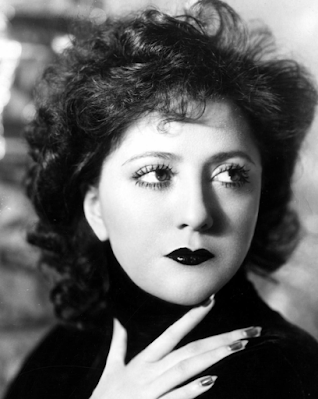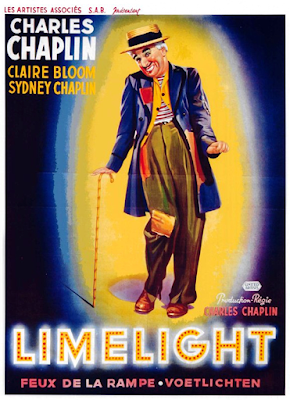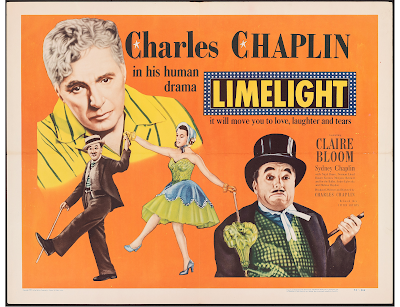Wonderland Burlesque's
Let's All Go To The Movies:
Cracked Actors
Part 1 of 2
Today, we take a look at motion pictures dealing with fictional Cracked Actors, performers who are truly losing their grip on reality.
Yes, it's the biz - show biz! All the glitz, all the glamour, all the glory.
It's all about getting your mug up there on the silver screen or getting that standing ovation. On the flip side - you're a never was, a could've been, a has-been, or a legend.
These are the used-to-be stars who now live with a touch of madness. Oh, yes... that which inspires great performances can turn on the practitioner, rendering the world at large risky or at great risk.
Today, it's all about broken vaudevillians and busted comics.
There's quite a bit to unpack with these particular films, which I relish. It's all delish, so let's take a look and dish on all that glitters, but doesn't necessarily lead to gold!
Al Howard may be a star on Broadway, but he is no longer welcomed by any producer. It seems that he just trots off to Mexico any time he wants causing shows to close and producers to lose money. When his sister Molly can no longer find him work, she teams him up with a talented dancer named Dorothy for a club date in Chicago. Flush with another success, Al wants to open his own club on Broadway, so he borrows money from a gangster to open the show. Al has Dorothy, who he ignores, the gangsters dough and the gangster's sweetie Luana. All he has to do is keep them all happy!
Based on the novel of the same name by Bradford Ropes, this musical drama film was directed by Archie Mayo and stars Al Jolson, Ruby Keeler, Glenda Farrell. Patsy Kelly, and Helen Morgan.
The film was shot at the Burbank Studios in Hollywood with sets designed by the art director John Hughes.
Years after the film's initial release, Jolson career was revitalized after the release of the 1946 Columbia Pictures film, The Jolson Story. Warner Bros. cashed in on the film's success by reissuing Go into Your Dance the following year.
Helen Morgan was a singer and actress who worked in films and on the stage. A quintessential torch singer, she made a big splash in the Chicago club scene in the 1920's. She starred as Julie LaVerne in the original Broadway production of Hammerstein and Kern's musical Show Boat in 1927, as well as in the 1932 Broadway revival of the musical, and appeared in two film adaptations, a part-talkie made in 1929 and a full-sound version made in 1936, becoming firmly associated with the role. She suffered from bouts of alcoholism, and despite her notable success in the title role of another Hammerstein and Kern's Broadway musical, 1929's Sweet Adeline, her stage career was relatively short. Helen Morgan died of cirrhosis of the liver at the age of 41. She was portrayed by Polly Bergen in the Playhouse 90 drama The Helen Morgan Story and by Ann Blyth in the 1957 biopic based on the television drama.
The story of a fading music hall comedian's effort to help a despondent ballet dancer learn both to walk and feel confident about life again. The highlight of the film is the classic duet with Chaplin's only real artistic film comedy rival, Buster Keaton.
Charles Chaplin, Ray Rasch, and Larry Russell won the Oscar for Best Original Score for this film, but it was the Oscar for films released in 1972! The picture had never played in a Los Angeles-area cinema during the intervening 20 years and was not eligible for Oscar consideration until it did.
Chaplin refused to allow the film to be distributed in Germany, unless the German audiences first were to see 1940's The Great Dictator.
Archie Rice, an old-time British music hall performer sinking into final defeat, is a failing third-rate music-hall stage performer desperately trying to keep his career going even as the music-hall tradition fades into history and his personal life falls apart.
This British kitchen sink drama was directed by Tony Richardson, produced by Harry Saltzman, adapted by John Osborne and Nigel Kneale from Osborne’s stage play of the same name and stars Laurence Olivier, Brenda De Banzie, Roger Livesey, and Joan Plowright.
According to the April 21, 1958, edition of Time Magazine, Sir Laurence Olivier turned down a Hollywood offer of $250K for one movie, choosing instead to take on the role of Archie Rice (a role written specifically for him). The actor earned 45 sterling pounds a week.
The original Broadway production by John Osborne opened at the Royale Theater in New York City on February 12, 1958, and ran for ninety-seven performances. Brenda de Banzie was nominated for the 1958 Tony Award for Supporting or Features Actress in a Drama for her role as Phoebe Rice, which she re-created in this movie.
A fictionalized account of the rise and fall of a silent film comic, Billy Bright. The movie begins with his funeral, as he speaks from beyond the grave in a bitter tone about his fate. It then takes us through his fame, as he ruins it with womanizing and drink, and his fall, as a lonely, bitter old man unable to reconcile his life's disappointments.
Writers Carl Reiner and Aaron Ruben wrote the story loosely based on the career of Buster Keaton, focusing primarily on the decline of his fortunes as tastes changed in Hollywood and his alcoholism. Some elements of the lives of Harold Lloyd and Mickey Rooney were also incorporated into this film.
In 1961, while starring in The Dick Van Dyke Show, Van Dyke called up Stan Laurel to ask for permission to do a Laurel & Hardy bit in an episode. Laurel told him that neither he nor Hardy's heirs owned the rights to the characters. Van Dyke and Reiner were horrified that Laurel didn't even own the rights to his own face, a revelation which inspired the creation of this film.
Mickey Rooney wore a special prosthetic in his right eye to play Cockeye. The character was originally supposed to be cross-eyed, but on the first day of shooting the actor claimed he was physically unable to do this. Director Carl Reiner confirmed this by placing his finger on the tip of Rooney's nose and telling him to look at it, without result. Reiner later said about Rooney, "This man could do everything in show business - sing, dance, act - but he couldn't cross his eyes!"
The film did poorly at the box office upon its release. Years later, Van Dyke said of The Comic: "very few people saw that movie, but we were proud of it."
There's quite a bit to unpack with these particular films, which I relish. It's all delish, so let's take a look and dish on all that glitters, but doesn't necessarily lead to gold!
--- ---
Go Into Your Dance
(1935)
AKA: Casino de Paris
It was released in Britain as Casino de Paris, named for one of the big musical numbers in the film.
This was the only film that Al Jolson and Ruby Keeler made together during their 12-year marriage, which lasted from 1928 to 1940.
Years after the film's initial release, Jolson career was revitalized after the release of the 1946 Columbia Pictures film, The Jolson Story. Warner Bros. cashed in on the film's success by reissuing Go into Your Dance the following year.
This film, a famous early musical, includes the numbers About a Quarter to Nine and Latin From Manhattan sung by Al Jolson. The former song was also recreated in color in the film 1946's The Jolson Story. Dance director Bobby Connolly received an Academy Award nomination for his work on the Latin from Manhattan. The film also features torch singer Helen Morgan singing The Little Things You Used To Do.
Helen Morgan
--- ---
Limelight
(1952)
Based on a novella by Charles Chaplin titled Footlights, this comedy/drama was written, produced, and directed by Charles Chaplin and stars Chaplin, Claire Bloom, and Buster Keaton. The score was composed by Chaplin and arranged by Ray Rasch.
Served as the final film of Edna Purviance. She was Chaplin's favorite co-star from the silent era, and remained close to Chaplin throughout her life. She rarely worked in films after the 1920's, but Chaplin kept her on his payroll until her death in 1958.
The first feature film in which Chaplin and Buster Keaton appeared onscreen together. This is often wrongly cited as their first onscreen meeting, but both appeared in a short publicity film in 1922 entitled Seeing Stars. Chaplin and Keaton had an interesting relationship. Long considered rivals but always having avoided commenting about each other in the press, Chaplin hired Keaton for a part in this film. Keaton, who was flat broke at the time, went into a career decline after having been signed by MGM in 1928, as the studio would not allow him to improvise in any of his films nor have any writing or directorial input. He was eventually reduced to writing gags, often uncredited, for other comedians' films. Chaplin, at this point, felt sorry for him due to his hard luck, but Keaton recognized that, despite Chaplin's better fortune and far greater wealth, it was Chaplin who was the more depressed of the two. In one scene in this film, Chaplin's character is dying, and while the camera is fading away, Keaton mutters to Chaplin without moving his lips, "That's it, good, wait, don't move, wait, good, we're through." In his autobiography Keaton called Chaplin "the greatest silent comedian of all time."
The rumor has been widely circulated that Keaton was much funnier than Chaplin in their scene together, so Chaplin cut Keaton's best scenes. In her book Buster Keaton Remembered, Keaton's widow Eleanor Keaton refutes this story; according to her, the rumor was started by Raymond Rohauer, Keaton's business partner. The point of the scene was to show Chaplin as Calvero having one final triumph before he has a heart attack and dies. It would not have made sense for Keaton, who was not even a major character in the movie, to outshine Chaplin.
When some scenes were reshot, Claire Bloom was unavailable, so Chaplin's wife, Oona Chaplin, stood in for her. She can be seen lying in the bed through the doorway after the housemaid has told Chaplin's character that his "wife" isn't eating. The children in Calvero's first scene, the ones who tell him the landlady isn't home, are Chaplin's own children. The film marks the debut of Geraldine Chaplin, who later played Charlie's mother Hannah in 1992's Chaplin.
At one point, Audrey Hepburn was under consideration for the role eventually filled by Claire Bloom.
In 1952, Chaplin sailed to London for the October 16th world premiere, but his re-entry permit was revoked after he left because of accusations that he was tied to the Communist party - a common charge during the 'Red Scare' era in the US made against those in the arts who raised questions or objections to American foreign or domestic policies. After showings of this film in New York and other East Coast cities, an anti-Chaplin frenzy whipped up by ultra-conservative politicians and organizations caused the cancellation of all showings in other cities.
Chaplin refused to allow the film to be distributed in Germany, unless the German audiences first were to see 1940's The Great Dictator.
Chaplin biographers have assumed that his character in the film was based on his father, Charles Chaplin Sr., who had also lost his audience and became an alcoholic, which led to his death in 1901. However, in both his 1964 autobiography and his 1974 book, My Life in Pictures, Chaplin insists that Calvero is based on the life of stage actor Frank Tinney. Limelight was made during a time where Chaplin was starting to lose his audience, too; in many ways, the movie was highly autobiographical.
The Entertainer
(1960)
John Osborne wrote this play specifically at the request of Olivier, who wanted the 'Angry Young Man' of the British theater to create a vehicle for him, one of the figures of the British Establishment, against whom Osborne was rebelling. Olivier hoped that appearing in the Osborne play would make him relevant to a new generation of theatergoers. It proved to be one of Olivier's greatest stage successes.
This served as the theatrical movie debut of Albert Finney and Alan Bates. It was the second theatrical movie of Joan Plowright. Despite having made her debut in 1957's Time Without Pity, she received an 'introducing' credit for this film. Olivier and Plowright met during the stage production of The Entertainer. At the time, Olivier's marriage to Vivien Leigh, whom he married in 1940, was disintegrating. Olivier and Plowright married in 1961 and remained so until Olivier's death in 1989.
In 1958, Olivier was nominated for a Tony Award for Actor in a Drama for his portrayal of Archie Rice in the stage version of The Entertainer. He was then nominated for an Oscar for Best Actor in a Leading Role for the subsequent film version. It was the sixth of ten such Oscar nominations.
--- ---
The Comic
(1969)
The film deals with the stresses related to the entertainment industry, alcoholism, and depression; three things Van Dyke was dealing with at the time of filming in real life. The actor would go into treatment in 1972 in order to clean up his act.
In his autobiography, Carl Reiner said he intended this as a vehicle for Dick Van Dyke who had, on the set of their TV show, often expressed the wish that he had been working at the same time as comedy legends such as his hero Stan Laurel.
--- ---
The Entertainer
(1975)
It was nominated for five Primetime Emmy's in the US, with Lemmon, Bolger and Thomson all getting nods for their work.
In an interview, Annette O'Toole talked about doing her very first nude scene in this film. "I've always looked at nudity like it's just part of it. You read about it when you first get the script; if you have any problem with it, then you don't go in for the part. To me, this happens to be my costume for the scene, it's just a little colder than normal. I remember the very first nude scene I did was with Jack Lemmon. We did a film called The Entertainer, which was a musical adaptation of a John Osborne play. We did a cut for American television, and a separate one for European film release. Of course, for the European one, we had to be naked and that was the hardest one because it was my first love scene. I remember before the scene, I was sitting thinking, 'In two hours, this will be over. You can do it!' And then when I got to the scene, it was as natural as anything. Maybe that's why I don't have that big a problem, because it's just another scene."


















































































2 comments:
I love that TMC runs old stuff like these.
OMG
Now I NEED to watch all of these!
The one about Charlie Chaplin, though.....
XOXO
Post a Comment